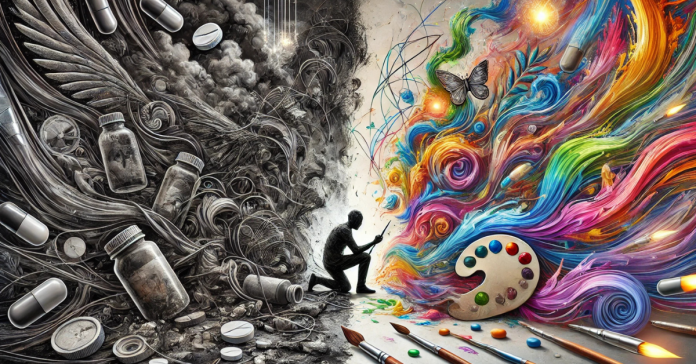You can be addicted to everything, gaming, alcohol, drugs, sex, shopping, food. Everything can be addiction. So why not addicted to creating and making original beautiful art?
addicted to making, thinking, building art and brands. Can you imagine? How can you treat this kind of addiction?
Understanding Art Addiction
Art addiction might manifest as an obsessive need to constantly create, driven by a desire to express oneself or to escape from other aspects of life. It can involve compulsively working on projects, feeling incomplete or anxious without creating, or being unable to stop making art even when it negatively impacts relationships, work, or health. While passion for creativity is positive, when it crosses into obsession, it can result in emotional burnout, neglect of other responsibilities, and strained relationships.
Signs of Art Addiction
–Excessive Time Spent Creating: Spending hours or even days immersed in artistic creation, often to the detriment of personal, professional, or social responsibilities.
–Neglect of Other Aspects of Life: Ignoring physical health, relationships, or work because art-making takes priority.
–Emotional Dependence: Feeling distressed or anxious when not creating art, or only feeling fulfilled when engaged in artistic activities.
–Inability to Stop: Even when one wants to take a break or when the body or mind requires rest, the urge to create is overwhelming.
Coping Strategies
If you or someone you know feels that art-making is becoming an addiction or is negatively affecting life, there are several strategies that can help restore balance:
–Set Time Limits: Establish boundaries for when and how long you will create art. This can involve setting specific hours during the day for artistic activities, while leaving the rest of the day open for other responsibilities. Using timers or scheduling can help remind you when it’s time to stop.
–Take Breaks: Regular breaks are essential to maintain mental clarity and creativity. Taking time off from art can also reduce the risk of burnout. Engage in other activities that promote well-being, such as physical exercise, socializing, or relaxation techniques. This helps your mind and body reset and prevents over-attachment to one single activity.
–Diversify Your Interests: Cultivate other hobbies or passions that bring joy and fulfillment. Whether it’s reading, cooking, gardening, or spending time in nature, exploring new activities can create a healthier balance in your life. A diverse range of interests helps shift your focus away from one thing and broadens your emotional and creative outlets.
–Mindfulness and Self-Reflection: Practicing mindfulness can help you become more aware of your compulsions and emotions related to art-making. When the urge to create becomes overwhelming, pause, take a deep breath, and reflect on why you feel the need to create at that moment. Are you avoiding something, or is it truly a healthy expression of your emotions?
–Create for the Right Reasons: Reassess your motivations for making art. Art can be a form of self-expression, therapy, or a way to connect with others, but it’s important to remember that creativity should feel fulfilling and not like a chore. Shifting your focus from product-oriented goals (such as creating art for recognition or success) to process-oriented ones (focusing on the enjoyment of creating itself) can help release unhealthy attachment to outcomes.
–Seek Support: If art-making is causing significant distress or disruption, talking to a therapist or counselor may help. Cognitive-behavioral therapy (CBT) can be especially effective in addressing compulsive behaviors. Support groups or art therapy can also provide outlets to discuss emotions and share experiences with others who may be facing similar challenges.
–Allow Imperfection: Let go of the need to always create something perfect. Sometimes, taking the pressure off yourself to produce high-quality work can free you from the compulsion to keep creating. Allowing yourself to create “bad” art or take breaks can promote a healthier relationship with your craft.
While art can be a wonderful and fulfilling activity, it’s important to maintain balance in life. If creating art begins to feel like an addiction, employing strategies like setting time limits, taking breaks, diversifying your interests, practicing mindfulness, and seeking support can help you regain control and ensure that art remains a positive force in your life.

